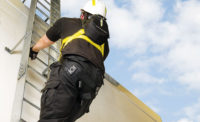Government, industrial, and commercial properties, such as military base complexes, manufacturing facilities, apartment buildings, and retail facilities, all must provide safe, dry, and clean environments, for working occupants, stored equipment, E-commerce goods and products, and utilities. Often, building and facility structures and finished materials, including for-purchase products, are made with Crystalline Silica, Amorphous Silica, and Quartz, and can create problematic particulate deposits when impacted, abraded, or otherwise produce fine dust. Silica Dust, created from Crystalline Silica, can be suspended in the air, accumulate on top of facility equipment and structures, accumulate on Fire Sprinkler Systems and Sprinkler Heads, migrate and accumulate in Exhaust Fans, Exhaust Hoods, HVAC Air Conveyance Systems, and ductwork. Silica Dust can also migrate and disperse to other unsuspecting areas in these facilities, and even impact nearby properties depending on the silica dust-producing activities, and environmental conditions.
These types of high surface and fugitive dust areas can impact indoor air quality, posing health risks to the occupants. OSH professionals and facility managers in charge of these facilities must prioritize the inspection of the property for possible Silica Dust. This article describes potential sources of Silica Dust and outlines best inspection practices, for OSH professionals, Certified Industrial Hygienists, and Certified Remediators, to perform the suspect Silica Dust inspection, when Silica Dust is suspected.
Note/disclaimer: (Some of these materials and substrates may also be a source of Asbestos Containing Materials, Lead Based Compounds/Particulates, or Combustible Dusts, and OSH and CIH professionals and facility managers will require additional safety precautions when inspecting).
What are Crystalline Silica Dust, Amorphous Silica, and Quartz?
Crystalline Silica is one of the most common minerals on earth and a major ingredient in glass and ceramic glazes. Silica is also used in the manufacture of building materials, in foundry castings, and for sandblasting, and respirable (breathable) crystalline silica particles are produced during quarrying and mining.
Amorphous Silica can be considered Diatomaceous earth, Diatomaceous silica, Diatomite, Precipitated amorphous silica, Silica gel, and Silicon dioxide (amorphous).
Quartz is a form of silica, it is a possible cause for concern in various workplaces.
Sources of Silica Dust
When operating, managing, and inspecting buildings and facilities, it is important for OSH and CIH professionals, to be aware of the various sources of Silica Dust. The following information identifies several potential sources of suspect Silica Dust.
Aggregate materials like sand, stone, concrete, and mortar contain crystalline silica. It is also used to make glass, pottery, ceramics, bricks, and artificial stone.
How is Silica Dust produced?
Open Pit Mining and Quarries, for aggregate materials and Quartz, produce dust deposits, dust air suspensions, and dust accumulations. In the manufactured stone industry, workers may also be exposed to silica dust when opening bags of ground quartz, moving or mixing bulk raw materials, cleaning and scraping mixers, or cleaning dust collector bag houses.
Chipping workers had the highest exposure levels and were investigated during demolition, crushing, and chipping, at several Massachusetts construction sites.
Factories like quartz crushing facilities (silica flour milling), agate, ceramic, slate pencil, glass, stone quarries, and mines, produce Silica Dust.
Construction workers who sand drywall joint compounds are often exposed to high concentrations of dust and, in some cases, respirable silica. Drywall joint compounds are made from many ingredients (i.e., talc, calcite, mica, gypsum, silica).
Cutting, Drilling, Scraping, Rasping, Sanding, Polishing, and Fitting, Natural Stone, Manufactured Stone, Plaster, Plaster of Paris, Drywall boards, Engineered Stone, Gypsum Boards, SheetRock, Cement boards, Fiber Cement Boards, and Tiles, also produce Silica Dust.
Stone Countertop Fabrication and Stone industry workers in shops and on job sites throughout the United States saw, grind, polish, and drill slabs of natural (mostly granite) and manufactured (man-made, engineered, or cultured) stone as part of manufacturing, finishing, and installing countertops. Workers operating powered hand tools, such as saws, grinders, and high-speed polishers, have some of the highest silica dust exposures in the countertop manufacturing, finishing, and installation industries. These exposures come from dry cutting, grinding, edging, and contouring stone, and may occur in shop environments as well as on job sites where finishing work is completed.
Excessive exposures were found in sandblasting, dismantling facade elements, diamond drilling, drilling hollow-core slabs, drilling with a drilling rig, priming of explosives, tiling, use of cabinless earthmoving machines, and jackhammering. Installing foundation and frame stages of new construction, yard work, interior work phases in the renovation and novel construction of apartment buildings, facade work, demolition of buildings, infrastructure construction, concrete waste, and stone crushing (pulverization)
Particulate Matter, (PM), generating dust emissions from coal mining operations and construction poses a specific and significant threat to miners’ and construction workers’ health. PM generated in these work environments contains organic and inorganic constituents, including silica, iron, metalloids, heavy metals, PAHs, and other contaminants.
OHSA Standard for Inspecting Suspect Silica Dust
OSHA Standard 1926.1153: Respirable Crystalline Silica, regulates all airborne occupational exposures to respirable crystalline silica in construction work, except where employee exposure will remain below 25 micrograms per cubic meter of air (25 μg/m3) as an 8-hour time-weighted average (TWA) under any foreseeable conditions. As opposed to airborne exposure, at present, a single direct relationship between silica dust sampled from a surface and potential human exposure does not exist. In addition, there is not even a protocol for surface sampling to reliably assess silica dust contamination. Even so, it is evident that contaminants’ exposed presence in occupied locations represents an obvious danger with unknown risks until these become properly assessed. Thus, important challenges exist when a need to evaluate silica dust migration and contamination presence over surface deposits.
When Silica Dust contamination is suspected to be present over surfaces in occupiable, non-industrial locations, or non-production areas of related industries, or ongoing migration of such fiber may pose indirect, non-occupational exposures, OSH and IH professionals and facility managers may benefit from having a safety inspection procedure in place to address both air and surfaces as well. Other inspection procedures associated with these conditions beyond the scope of this article may include proper Personal Protective Equipment, (PPE), per O.S.H.A. and E.P.A. guidelines, as required. A suspect Silica Dust inspection should also include a Safety Plan for emergencies, possible Confined Space training, and making sure communicating devices are operating, with a backup device and plan. A plan of action, documentation, and a communication chain of command are critical for safety and awareness. Some proposed best practices to consider for surface silica dust inspections are discussed below.
Conducting a visual inspection and surface sampling, for silica dust in project areas
Silica content is part of many building materials. Disturbance, impact, handling, and use of such materials may pose exposure risks directly to workers on site and secondary exposures from potential migration, deposition, and resuspension of such mineral fibers at other nearby locations. We can think of it in terms of, for example, the uncontrolled production of silica dust at a residential renovation project where concrete substrates are being impacted, and such silica dust is migrating to the adjacent residential unit where it gets settled down over miscellaneous horizontal surfaces. Then it becomes resuspended with typical occupants’ activities. Even though the presence of silica in settled dust is not regulated, once resuspended in the air, the dust may become a major source of silica exposure. The level of silica contamination can be used as an indicator of past exposure, and good/bad housekeeping, and potentially identify a source of dust contamination.
The practicality of this proposed surface sampling is primarily to aid in establishing surface conditions at suspected areas regarding settled concentrations of quartz, a common form of silica, a major mineral component of cement, and thus a typical surrogate for assessing Portland cement dust contamination. In addition, a detailed ocular assessment may focus on documenting surface dust contamination signs as well as susceptible pathways potentially enabling contaminants’ migration from identifiable suspected sources. Due to the lack of a specific industry standard for the collection of Surface Samples for Silica Dust, a settled dust sampling could reference ASTM Standard E1728: Standard Practice for Collection of Settled Dust Samples Using Wipe Sampling Methods for Subsequent Lead Determination and ASTM Standard D6966: Standard Practice for Collection of Settled Dust Samples Using Wipe Sampling Methods for Subsequent Determination of Metals. In addition, references can also made to the NIOSH Manual of Analytical Methods (NMAM), 4th Edition; Silica, Crystalline, by XRD: METHOD 7500, and OSHA ID-142.
Because there are no established regulatory and risk ranking levels for settled silica dust concentrations, the analysis results’ interpretation could be based on a semi-quantitative “presence” versus “non-detection” evaluation of the said contaminant over the representative surfaces assessed. At present, a single direct relationship between silica dust sampled from a surface and potential human exposure does not exist. Even so, it is evident that contaminants’ exposed presence in occupied locations represents an obvious danger with unknown risks until these become properly assessed.
Even though membrane filters’ size poses important handling challenges during this proposed protocol, surface samples might be collected, to the extent possible, based on ASTM Method E1728 – 16, using 5um PVC membrane filters (no cassette) as quartz wipes and disposable templates measuring 10 cm by 10 cm. The cited method comprises the following steps:
- A clean pair of gloves is used per sample.
- A disposable template measuring 10 cm by 10 cm is placed over the identified area.
- The wipe is removed from its package and inspected.
- The wipe is moistened with methanol before sample collection.
- Positioning the hand open and flat with the fingers together the wipe is placed on the surface to be sampled; the selected surface area is wiped side to side, in an overlapping “S” or “Z” pattern while applying pressure to the fingertips; the surface is wiped until the entire selected surface area is covered.
- The wipe is folded in half with the collected dust side folded inward; the preceding wiping procedure is repeated within the selected sampling area using an up-and-down overlapping “S” or “Z” pattern.
- The wipe was folded in half again with the collected dust side folded inward, and the wiping procedure was repeated one more time, concentrating on collecting settled dust from all corners within the selected surface area.
- The wipe is folded again with the collected dust side folded inward and inserted into a sample container. The sample containers are resalable, rigid-walled, 50-mL minimum volume.
- The disposable gloves are disposed of after each sample.
- One (1) field blank sample is managed for quality control per the referenced method. An unexposed wipe is removed from their packaging and placed into sample containers.
Recommendations and best practices, for elimination of sources of silica dust
Eliminating, decreasing, and limiting all sources of Cutting, Grinding…etc will help prevent Silica Dust. After inspecting for suspect Silica Dust projects and areas, an initial plan of action can be created and implemented. Several recommendations for decreasing sources of Silica Dust may include:
- Inspect all HVAC air conveyance units and ductwork for proper operation, calibration, any air leakage, and open penetrations
- Inspect all roofing, roof hatches, windows, exhaust fans, entrances, and exit doorways for proper sealing out of weather elements and open penetrations
- Inspect all PPE, work clothing, street clothing, shoes, bedding, curtains, containers, boxes, bags, Lighting, Wall Pictures, furniture, carpet, and floors, for Silica Dust accumulations and re-suspensions
- Dispose of, or HEPA vacuum and or wash clean, PPE, work clothing, street clothing, shoes, bedding, curtains, containers, boxes, and bags, Lighting, Wall Pictures, furniture, carpet, and floors, for Silica Dust accumulations and re-suspensions
These best practices and recommendations for inspecting suspect Silica Dust will allow a property owner to have better knowledge, to inspect for suspect Silica Dust, in government, industrial, and commercial properties, and will help prevent secondary damages to their property. These best practices and recommendations will also allow safe planning and execution of future suspect Silica Dust inspections, in government, industrial, and commercial properties, for OSH professionals, Certified Industrial Hygienists, and Certified Remediators.
References
ASTM-E2625 › Standard Practice for Controlling Occupational Exposure to Respirable Crystalline Silica for Construction and Demolition Activities https://www.document-center.com/standards/show/ASTM-E2625
ASTM D7948-20 Standard Test Method for Measurement of Respirable Crystalline Silica in Workplace Air by Infrared Spectrometry Source: https://www.astm.org/d7948-20.html
Determination of Crystalline Silica in Dust at Low Concentrations by Low-Temperature Infrared Spectrometry: The American Conference of Governmental Industrial Hygienists (ACGIH) accepted a lower threshold limit value (TLV) for respirable crystalline silica (RCS) exposure of 25 μg/m3, half of the previous TLV. Source: https://www.ncbi.nlm.nih.gov/pmc/articles/PMC4635073/
Centers for Disease Control and Prevention, (C.D.C.), “Control of Drywall Sanding Dust Exposures,” https://www.cdc.gov/niosh/docs/99-113/default.html Published June 6, 2014, Accessed August 5, 2023.
Centers for Disease Control and Prevention, (C.D.C.), “OSHA/NIOSH Hazard Alert: Worker Exposure to Silica during Countertop Manufacturing, Finishing and Installation,” https://www.cdc.gov/niosh/docs/2015-106/default.html Published February 19, 2015, Accessed August 5, 2023.
Centers for Disease Control and Prevention, (C.D.C.), Silica, https://www.cdc.gov/niosh/topics/silica/default.html Published July 11, 2023, Accessed August 5, 2023.
Centers for Disease Control and Prevention, (C.D.C.), Silica, amorphus, https://www.cdc.gov/niosh/npg/npgd0552.html Published October 30, 2019, Accessed August 5, 2023.
Centers for Disease Control and Prevention, (C.D.C.), “Silica Hazards from Engineered Stone Countertops,” https://blogs.cdc.gov/niosh-science-blog/2014/03/11/countertops/ Published August 13, 2020, Accessed August 5, 2023.
National Center for Biotechnical Information, National Library of Medicine, PubMed Central, “An evaluation of on-tool shrouds for controlling respirable crystalline silica in restoration stone work,” https://pubmed.ncbi.nlm.nih.gov/25261456/ Published 2014 Nov;58(9):1155-67. doi: 10.1093/annhyg/meu069. Epub 2014 Sep 26, Accessed August 5, 2023.
National Center for Biotechnical Information, National Library of Medicine, PubMed Central, “Characterization of Occupational Exposures to Respirable Silica and Dust in Demolition, Crushing, and Chipping Activities,” https://pubmed.ncbi.nlm.nih.gov/30379992/ Published 2019 Jan 7;63(1):34-44. doi: 10.1093/annweh/wxy089, Accessed August 5, 2023.
National Center for Biotechnical Information, National Library of Medicine, PubMed Central, “Exposures and health effects from inorganic agricultural dusts,” https://www.ncbi.nlm.nih.gov/pmc/articles/PMC1637665/ Published 2000 Aug; 108(Suppl 4): 661–664. doi: 10.1289/ehp.00108s4661, Accessed August 5, 2023.
National Center for Biotechnical Information, National Library of Medicine, PubMed Central, “Long-Term Exposure to Silica Dust and Risk of Total and Cause-Specific Mortality in Chinese Workers: A Cohort Study,” https://www.ncbi.nlm.nih.gov/pmc/articles/PMC3328438/ Published online 2012 Apr 17. doi: 10.1371/journal.pmed.1001206 , Accessed August 1, 2023.
National Center for Biotechnical Information, National Library of Medicine, PubMed Central, “Managing Quartz Exposure in Apartment Building and Infrastructure Construction Work Tasks,” https://www.ncbi.nlm.nih.gov/pmc/articles/PMC10138895/ Published online 2023 Apr 7. doi: 10.3390/ijerph20085431, Accessed August 5, 2023.
National Center for Biotechnical Information, National Library of Medicine, PubMed Central, “Non-occupational exposure to silica dust,” https://www.ncbi.nlm.nih.gov/pmc/articles/PMC3683189/ Published online 2012 Sep-Dec; 16(3): 95–100. doi: 10.4103/0019-5278.111744, Accessed August 5, 2023.
National Center for Biotechnical Information, National Library of Medicine, PubMed Central, “The Evaluation of Worker Exposure to Airborne Silica Dust During Five OSHA Table I Construction Tasks,” https://pubmed.ncbi.nlm.nih.gov/36882024/ Published 2023 Jun 6;67(5):572-583. doi: 10.1093/annweh/wxad012, Accessed August 5, 2023.
National Center for Biotechnical Information, National Library of Medicine, PubMed Central, “Understanding the pathogenesis of occupational coal and silica dust-associated lung disease,” https://www.ncbi.nlm.nih.gov/pmc/articles/PMC9724915/ Published online 2022 Jul 13. doi: 10.1183/16000617.0250-2021, Accessed August 1, 2023.
National Institute for Occupational Safety and Health, (N.I.O.S.H.), NIOSH [2015]. “Reducing hazardous dust exposure when cutting fiber-cement siding.” https://www.cdc.gov/niosh/docs/wp-solutions/2015-185/pdfs/2015-185.pdf By Qi C, Whalen JJ. Cincinnati, OH: U.S. Department of Health and Human Services, Centers for Disease Control and Prevention, National Institute for Occupational Safety and Health. DHHS (NIOSH) Publication No. 2015–185. Published June 2015, Accessed August 5, 2023.
Taylor & Francis Group, Informa UK Limited 2023, “Determinants of Respirable Silica Exposure in Stone Countertop Fabrication: A Preliminary Study,” https://www.tandfonline.com/doi/abs/10.1080/15459624.2013.789706 Published online:13 May 2013 https://doi.org/10.1080/15459624.2013.789706,, Accessed August 5, 2023.
The Agency for Toxic Substances and Disease Registry, (ASTDR), “Silica ToxFAQs™,” https://acrobat.adobe.com/link/review?uri=urn%3Aaaid%3Ascds%3AUS%3Ad73adbf4-75ee-3a56-8dbe-bda9a4b7e2af Published January, 2020, Accessed August 5, 2023
The American Conference of Governmental Industrial Hygienists, (ACGIH), “Determination of Crystalline Silica in Dust at Low Concentrations by Low-Temperature Infrared Spectrometry: accepted a lower threshold limit value (TLV) for respirable crystalline silica (RCS) exposure of 25 μg/m3, half of the previous TLV.” Source: https://www.ncbi.nlm.nih.gov/pmc/articles/PMC4635073/
U.S. Department of Labor, Occupational Safety and Health Administration, (O.S.H.A.), Standard Number 1926.1153 - Respirable crystalline silica, https://www.osha.gov/laws-regs/regulations/standardnumber/1926/1926.1153 Published May 19, 2014, Accessed August 5, 2023.
U.S. Department of Labor, Occupational Safety and Health Administration, (O.S.H.A.), https://www.osha.gov/silica-crystalline Published March 25, 2016, Accessed August 5, 2023.
U.S. Department of Labor, Occupational Safety and Health Administration, (O.S.H.A.), “Silica, Crystalline,” https://www.osha.gov/silica-crystalline Published March 25, 2016, Accessed August 5, 2023. (On March 25, 2016, OSHA published a final rule regulating occupational exposure to respirable crystalline silica (81 FR 16286), https://www.regulations.gov/document/OSHA-2010-0034-4254
Wikipedia, Wikipedia Foundation Inc., “Cement Board,” https://en.wikipedia.org/wiki/Cement_board Published April 12, 2023, Accessed August 5, 2023.
Wikipedia, Wikipedia Foundation Inc., “Drywall,” https://en.wikipedia.org/wiki/Drywall Published July 12, 2023, Accessed August 5, 2023.
Wikipedia, Wikipedia Foundation Inc., “Fiber Cement,” https://en.wikipedia.org/wiki/Fibre_cement Published March 12, 2023, Accessed August 5, 2023.
Wikipedia, Wikipedia Foundation Inc., “Plaster,” https://en.wikipedia.org/wiki/Plaster Published August 2, 2023, Accessed August 5, 2023.
Wikipedia, Wikipedia Foundation Inc., “Quartz,” https://en.wikipedia.org/wiki/Quartz#:~:text=Quartz%20is%20a%20hard%2C%20crystalline,chemical%20formula%20of%20SiO2 Published August 4, 2023, Accessed August 5, 2023.



